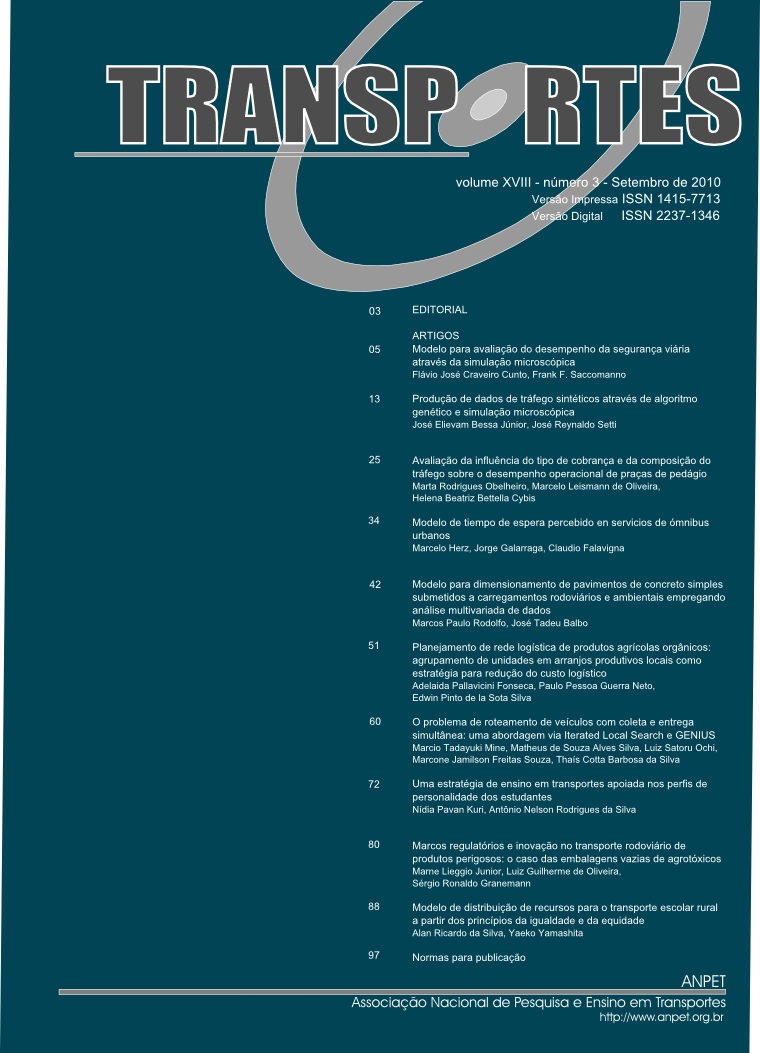Produção de dados de tráfego sintéticos através de algoritmo genético e simulação microscópica
DOI:
https://doi.org/10.14295/transportes.v18i3.447Abstract
Resumo: Neste artigo, propõe-se um método para produzir, por meio de um simulador, uma série de dados de tráfego sintéticos que representem diversas condições operacionais e comportamentais, como os fornecidos por sensores instalados nas vias. O método proposto baseia-se num algoritmo genético (AG), que automaticamente calibra um modelo de simulação microscópico. Entre os cromossomos (soluções) gerados pelo AG na calibração do simulador, são escolhidos os que produzem resultados marginalmente inferiores ao ótimo. As distribuições de valores dos parâmetros que formam os cromossomos deste subconjunto são usadas para gerar, através de uma amostragem de Monte Carlo, parâmetros para as replicações da simulação que são usadas para produzir os dados sintéticos. A viabilidade do método proposto é demonstrada através de um estudo de caso, no qual o simulador usado foi o TWOPAS e os dados de tráfego foram obtidos de sensores instalados no km 98 da SP98, uma rodovia de pista simples no estado de São Paulo.
Abstract: The paper proposes a method for generating, by a simulator, synthetic traffic data which represents a wide range of operational and behavioral conditions, such as those obtained from detectors installed on roads. The proposed method uses a genetic algorithm (GA) to calibrate a traffic simulation model automatically. A subset of chromosomes (solutions) generated by the GA during the calibration of the simulator containing those that produce results marginally inferior to the best solution is used to produce distributions of feasible values for the simulation model parameters. The distributions of simulation model parameters contained in the chromosomes of this subset of solutions are used to produce, by Monte Carlo sampling, parameters for the simulations that generate the synthetic data. The feasibility of the proposed approach is demonstrated by a case study using TWOPAS and data from detectors installed on SP98, a two-lane highway in the state of São Paulo, Brazil.Downloads
Downloads
Published
How to Cite
Issue
Section
License
Authors who submit papers for publication by TRANSPORTES agree to the following terms:
- The authors retain the copyright and grant Transportes the right of first publication of the manuscript, without any financial charge, and waive any other remuneration for its publication by ANPET.
- Upon publication by Transportes, the manuscript is automatically licensed under the Creative Commons License CC BY 4.0 license. This license permits the work to be shared with proper attribution to the authors and its original publication in this journal.
- Authors are authorized to enter into additional separate contracts for the non-exclusive distribution of the version of the manuscript published in this journal (e.g., publishing in an institutional repository or as a book chapter), with recognition of the initial publication in this journal, provided that such a contract does not imply an endorsement of the content of the manuscript or the new medium by ANPET.
- Authors are permitted and encouraged to publish and distribute their work online (e.g., in institutional repositories or on their personal websites) after the editorial process is complete. As Transportes provides open access to all published issues, authors are encouraged to use links to the DOI of their article in these cases.
- Authors guarantee that they have obtained the necessary authorization from their employers for the transfer of rights under this agreement, if these employers hold any copyright over the manuscript. Additionally, authors assume all responsibility for any copyright infringements by these employers, releasing ANPET and Transportes from any responsibility in this regard.
- Authors assume full responsibility for the content of the manuscript, including the necessary and appropriate authorizations for the disclosure of collected data and obtained results, releasing ANPET and Transportes from any responsibility in this regard.









